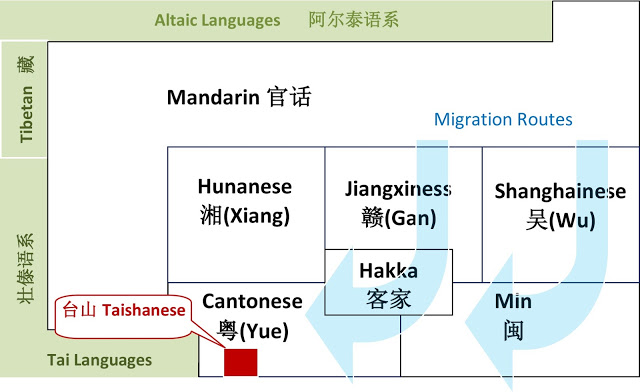I drew the following grossly oversimplified map to give myself a mental picture of the seven major dialect groups that make up the Chinese language family.
The linguistic map of China is a manifestation of its geography. The great plains of the north facilitated the dominance of a single dialect family. The South, with its numerous mountains and rivers making communication difficult, is thriving with numerous tones.
It is also a reflection of history. For example, the Min dialect retains a lot of old Wu characteristics because many of its early immigrants were from the Wu-speaking region.
The Xiang and Wu dialect regions were once joined and considered a single language family by some. However, beginning around 300 AD, due to wars and invasions by Altaic-speaking nomadic tribes from the north, the thousand-year long southward migration of people from central China drove a wedge between the Wu/Xiang speaking regions and eventually split them apart completely. Along this migration path, a new dialect was formed -- Gan is thus a transitional language that share many similarities with its neighbors. This Great Migration also played a central role in the formation of the Cantonese and Hakka dialect groups.
The first large-scale migration of people from Central China to the present-day Cantonese-speaking region were soldiers and prisoners sent by the Chin Emperor around 220 BC. They intermarried and coexisted with the natives who speak varieties of the Tai languages. Five hundred years later, the Great Migration mentioned above, came in waves lasting about a thousand years, gradually changed the ethnic makeup and assimilated the locals. The Cantonese dialect is thus representative of the then northern tone with strong Tai linguistic influences.
The Cantonese dialect is further divided into six sub-dialects (次方言). The division is controversial, but everyone is pretty much in agreement with the Four-Counties (四邑片) classification because of its standout phonology.
Today, there are approximately four million native speakers of this particular variety of Cantonese (known as Taishanese/Toisanese 台山话 in the U.S.) in the Four-Counties area. In addition, there are an estimated 3.5-3.6 million Four-Counties descendants living abroad in over 107 countries and regions. Their top destinations include Hong Kong (1.5 million incl. Macau) and North America (US/Canada 1.4 million).
